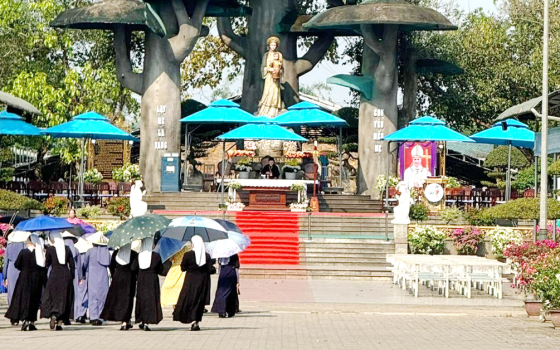"The glass is half-full for me, not half-empty," said Pat Hayes, a teacher's assistant at St. Mary's Academy in Hoosick Falls and a parishioner of Immaculate Conception parish there.
Her glass may be half-full, but that doesn't mean she should be drinking it.
Hoosick Falls and surrounding areas are dealing with a water crisis because of the amount of perfluorooctanoic acid, or PFOA, in their water. The man-made chemical got into the water supply after being used by the area's Saint-Gobain Performance Plastics factory in manufacturing Teflon coatings.
Saint-Gobain is now classified as a state Superfund site because of the hazardous waste disposed of there. New York State's Department of Environmental Conservation said it "presents a significant threat to public health and/or the environment."
A federal "Superfund" law was passed in 1980 and states followed suit with their own laws to clean up sites contaminated with hazardous substances and pollutants.
"It seems as though there was a lot of dumping of chemicals here in the past," Fr. Thomas Zelker, pastor at Immaculate Conception, told The Evangelist, newspaper of the diocese of Albany. "We have wells along the river here in Hoosick Falls. Everyone has wells, and they are finding those are contaminated."
Ironically, Zelker's former career gives him a unique perspective: After receiving a degree in forestry from the State University of New York's College of Environmental Science and Forestry, in Syracuse, the priest worked under then-Albany Mayor Erastus Corning II on inspecting the city's water supply. He was employed at the Alcove Reservoir, which supplies water to the city of Albany.
"Albany's water was very clean," Zelker recalled.
The situation in Hoosick Falls is being addressed. At the beginning of March, the New York state Department of Environmental Conservation and Department of Health announced that they would be installing 190 water filtration systems and would continue to flush out the village's water mains and the pipes of all buildings connected to the village's contaminated water system. Perfluorooctanoic acid is regulated in many other states, but it had not been addressed in New York until now.
The state agencies also have released fact sheets for the community and have rented out a former car dealership as a home base for meetings, said Zelker.
The New York community is not alone in facing a water crisis. In Michigan the residents of Flint have been coping with contaminated drinking water for almost two years. That situation was the subject of hearings in Washington on Thursday. The same day, public school officials in Newark, N.J., released findings that show students at nearly half of the city's schools may have been drinking water with elevated levels of lead.
More: "Immigrants have been arrested looking for alternatives to Flint water" (March 21, 2016)
In Hoosick Falls, Immaculate Conception parishioner Maggie Kinney told The Evangelist that she tries to stay as well-informed as possible about the status of the water crisis.
"I'd rather be part of the solution than part of the problem," explained Kinney, who owns a beauty parlor in town. She's been trying to answer her customers' questions with facts to stop speculation and public unrest. "If I don't have an answer, I don't pretend to," she noted.
Hoosick Falls residents are allowed to use the contaminated water for almost everything but drinking and cooking. When washing dishes, they must wipe them off immediately, Zelker told The Evangelist.
"Even (when it comes to) water for Mass, it has to be a bottle of water," he said. Bottled water is mixed with the wine for the Eucharist, and it was used in the holy water fonts until Lent, when the fonts are drained.
When Easter rolls around and baptisms increase, Zelker will fill the baptismal font with bottled water. He also noted that, when sprinkling the congregation with holy water on Easter Sunday, he will not be using the village's contaminated water.
Saint-Gobain has provided free bottled water at the local grocery store, with daily rations for families. Larger institutions, such as Immaculate Conception parish and St. Mary's Academy, get bottled water delivered.
"There's a big element of fear," said Zelker, adding that the local economy is declining because many people do not want to buy homes in an area where they can't drink the water. "The banks pulled out from many mortgages."
At St. Mary's Academy, "all of our water fountains that have been hooked to the village water are disconnected and covered," said interim principal Michael Piatek. "All of the kids and the faculty have adjusted to the situation." Teacher's assistant Hayes isn't too concerned about her own health. Her family has been in the area for generations, she said, and she's been drinking Hoosick Falls water her entire life. Her concern is for future generations.
"I want my grandchildren to be safe. They all live in the community," she explained. "But they've been drinking bottled water for a long time," since they didn't like the taste of the Hoosick Falls water.
The community is working together on the water problem. Kinney said that many local teenagers have been stepping up to help deliver water to the homebound.
The water crisis is "just something you have to get used to," said Hayes. "We are a very positive community. We have always been there, neighbor for neighbor. Let's remain a caring and loving community."
Zelker appreciates the help of volunteers who deliver water, but said the task is "taking a toll on the people."
He's relieved that the mild winter made the task slightly easier.
Editor's note: Want more stories from Eco Catholic? We can send you an email alert once a week with the latest. Just go to this page and follow directions: Email alert sign-up.





